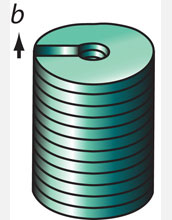| Posted: April 22, 2010 |
Scientists take first step toward controlling the growth of nanomaterials without catalysts |
|
(Nanowerk News) Researchers at the University of Wisconsin-Madison recently made a significant first step toward understanding how to control the growth of the nanotubes, nanowires and nanorods needed for renewable energy and other technology applications.
|
|
These nanocrystalline materials, or nanomaterials, possess unique chemical and physical properties that can be used in solar energy panels, high energy density batteries, or better electronics. But, writing in the April 23 edition of the journal Science, a UW-Madison research team notes that the formation of these materials is often not well understood.
|
|
In particular, the question of how one-dimensional (1D) crystals grow sometimes without catalysts has been troublesome for scientists and engineers who need to produce large amounts of nanomaterials for specific applications. Working with zinc oxide, a common semiconductor widely used as a nanomaterial, assistant professor of chemistry Song Jin and his students demonstrated a new understanding of the subject by showing that nanotubes can be formed solely due to the strain energy and screw dislocations that drive their growth.
|
 |
| A schematic illustration showing the formation of nanotubes driven by screw dislocations.
|
|
Screw dislocations are frequently observed defects in crystalline materials that can be thought of as a screw or a helical staircase that can drive fast 1D crystal growth. But these defects produce strain and stress during nanotube formation.
|
|
"The strain energy within dislocation-driven nanomaterials dictates if the material will be hollow or solid," explained Jin. "Tubes are formed when strain energy gets large enough and the center of the nanostructure hollows out to relieve the stress and strain."
|
|
Jin and his students investigated the possibility of dislocation-driven growth by carefully regulating the amount of available nanotube building blocks in a solution. Essentially, the team controllably oversaturated or supersaturated a vat of water with zinc salts to favor dislocation-driven growth and observe the formation of solid nanowires and hollow nanotubes.
|
|
This mechanism differs from previous growth strategies in that it doesn't require a catalyst or a template to produce nanotubes, but relies solely on a dislocation and the strain energy associated with it. A catalyst is usually another metal nanoparticle such as gold added to the growth process, which in turn drives 1D growth.
|
|
"Once we understand that the growth of these 1D nanomaterials can be driven by screw dislocations, we can see nanotubes and nanowires are related." said Jin. "Furthermore, we've shown that growth of nanotubes or nanowires without the use of a catalyst in solutions can be rationally designed by following a fundamental understanding of crystal growth theories and the concept of dislocation-driven nanomaterial growth.
|
|
"For more practical purposes, we think that this work provides a general theoretical framework for controlling solution nanowire/nanotube growth that can be applicable to many other materials," Jin said.
|
|
Growing large amounts of nanotubes or nanowires from water-based solutions without a catalyst would be much more cost-effective. "This could open up the exploitation of large scale/low cost solution growth for rational catalyst-free synthesis of 1D nanomaterials," said Jin.
|

